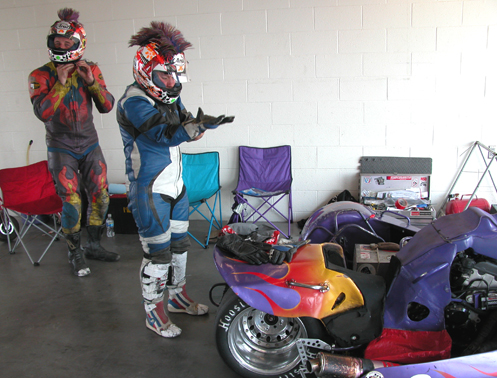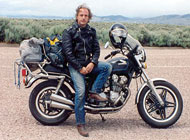Examiner Resurrection: Sidecar Racing: High-Speed Ballet
Money and horsepower do not produce winners in sidecar racing. It takes teamwork, and a good team can make a poor machine very, very fast.
So say the folks who ought to know, the sidecar racers I spoke with (and rode with!) at last weekend’s Bonneville Vintage GP and Concours.
Wade Boyd and Christine Blunck are the points leaders for both driver and passenger as this racing season nears its end, and they were the ones I chanced to strike up conversation with as I sought to learn more about this sport. I also spoke with Rick Murray, the outgoing president of the Sidecar Racers Association-West.
Wade got into sidecar racing unexpectedly when he showed up at the Isle of Man TT one year expecting to race in three events. Finding that he had been shut out of two events, “I told my girlfriend to find me a sidecar.” He had never ridden a sidecar before but she found a driver in need of a passenger and he agreed to take Wade.
“I had a dynamite time, and then for four years it was like I had my thumb out. I’d go without having anything set and I’d find someone who needed a rider. Then I got to drive . . .”
Christine’s first involvement with racing was as an umbrella girl at various races, but she had a friend who ran a motorcycle shop, and who said of sidecar racing, “We could do that.”
That’s often how it happens, says Rick. “Quite often you have two friends or relatives who want to race together. We have many husband/wife, father/son, sister/sister teams. We have a fairly high percentage of women in the sport.”
Wade concurs, saying “Where else do you get to take a buddy for a ride?”
Wade is a steel fabricator by trade and he built his own rig for the most part, although “Mr. Bill” Becker of Becker Motor Works helped him out putting the motor in and with some of the other big stuff. Mr. Bill is known by all U.S. sidecar racers because he helps nearly all of them keep their rigs running.
That sort of helpfulness is characteristic of sidecar racing. “We’re competitive but friendly,” says Wade. “We want you out there and I want to pass you fair and square.”
It’s all about teamwork
The key to running a fast race is the teamwork. Each team pre-rides the track and then maps out their strategy for each turn on the course. On most turns the passenger will hang their weight out to enable fast turns without the third wheel rising off the pavement, or floating. That loss of traction cuts speed. However, in some instances, “letting the chair float” allows the rig to cut the corner sharper in order to get up speed in a hurry for the straightaway.
The passenger needs to know his or her position on each turn and the driver needs to be aware of the passenger’s location. On occasion the driver will look back but usually, “I feel her, the ESP is strong,” says Wade.
The passenger also needs to make their moves smoothly and gracefully. Harsh, forceful moves from one position to another will negatively affect the handling of the rig. Wade calls this coordinated, smooth movement “high-speed ballet.”
Despite the seemingly dangerous risks the passengers take, leaning far out of the rig just inches above the ground, sidecar racing in the U.S. is actually very safe. By comparison, Wade says, at the Isle of Man TT “they put a bale of hay in front of a telephone pole. After doing the TT, this (the track at Miller Motorsports Park) is easy. We rarely touch, but if you do touch you’re probably going to spin out, and if you spin out the passenger can get launched.”
According to Rick, the last sidecar racing fatality in the U.S. occurred in the 1980s, and there have been only three fatalities since the 1960s.
Passengers do sometimes get “spit off.” Christine’s most memorable such occasion came in Ramsey, on the Isle of Man when her driver clipped a curb in an S-curve. “It spit me off and I flipped through the air and landed upright on my feet in some gentleman’s front yard. I said ‘Hi’ and introduced myself.” She adds that there are times when the passenger wishes he or she was a monkey, and had that tail as a fifth hand to hang on with.
Sidecar racing is an inexpensive way to race, Rick notes, because you split the cost two ways. Plus, using wide, slick tires, as modern sidecars do, the costs are low because a set of tires will last one to two years. And most racers run stock engines so reliability is very high.
Still, there aren’t that many sidecar racers in the U.S., and they’d love to see that change. That’s one reason Rick and others love to offer “taxi rides” to spectators when they can. These taxi rides let non-racers suit up and take two laps around the track with an experienced driver at the controls.
“I tell people you’ll love it or hate it,” says Rick. “I’ve never seen anybody go half way. They’re either ‘Get me off’ or ‘Where can I buy one?'”
And if you do love it, says Rick, “You can spend $4,000 to $5,000 and have something to have fun with.”
Biker Quote for Today
Sometimes your knight in shining armor turns out to be a biker in dirty leathers.
Tags: racing sidecars

